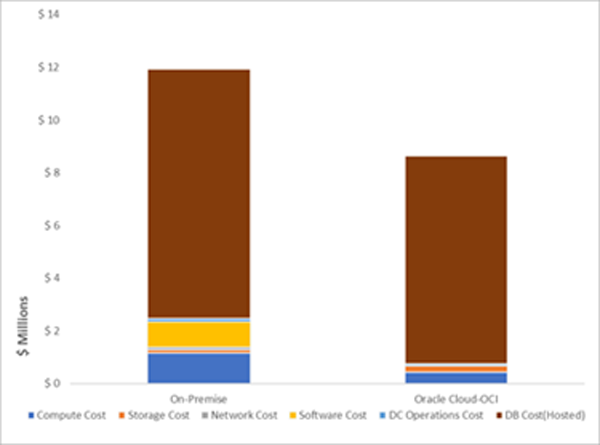Migrating to the cloud seems like table stakes for the modern enterprise. When contemplating the move, there are a number of things to consider, cost always being high on the list. For Oracle customers considering a migration to Oracle Cloud Infrastructure (OCI), the migration eliminates the periodic expense of replenishing on-premise equipment every few years to gain a technical advantage. Moving to the cloud can also help companies better manage ongoing costs like storage and compute expenses. Yet companies still need a reliable way to evaluate the cost-saving advantages that a cloud model offers.
Breaking Down the OCI TCO Calculator
Knowing the cost of running individual workloads in OCI is not difficult. But organizations need a complete view of all costs and expenses to be able to accurately assess the true savings of migrating to the cloud. Historically, determining that cost has been difficult.
The cost benefit of a cloud migration is the most frequently raised issue in customer conversations. And the challenge of quantifying the benefits of a cloud migration -- and which levers can improve the total cost of ownership (TCO) -- are a major concern for all of them.
Wipro evaluates on-premise to cloud comparison with six important tenets:
Breaking the analysis into these six categories yields an accurate and detailed evaluation of costs. The model helps companies analyse their on-premise spend and see the reduced TCO by providing a cost comparison with OCI and avoiding the upfront CAPEX investment to drive the OPEX model. This is a breakdown of the benefits gained by using the OCI TCO Savings Calculator:
Features and Benefits of the TCO Savings Calculator
| Features | Benefits |
|---|---|
Quantitative analysis of server inventory |
Clear cost comparison for better decision making |
Minimal submission of requirements |
Analysis includes Net New and BYOL model for database |
Editable cost assumptions to fit customer requirements |
Rack to stack inclusion for TCO Calculation |
| Graphical representation of TCO comparison | Improved long-term financial performance |
TCO Savings: Analysis for Two Customers
Wipro has helped many Oracle customers evaluate their cloud migration TCO, using this experience to develop a model for the savings calculator. The proof is in the results. Here
are two real examples:
Example 1
A leading nutrition company needed to evaluate the comparison for hosting its workloads on-premise vs Oracle Cloud Infrastructure. The customer wanted to understand the quantitative advantage of choosing OCI vs the local hardware refresh.
Wipro assessed the on-premise components – database, RAC, partitions, diagnostics,
and tuning packs – along with other hardware requirements. The client would incur a significant one-time refresh cost, and the applications would require annual expenses for support and maintenance.
Leveraging the TCO Savings Calculator, the customer learned that moving to OCI would convert many of the one-time costs into pay-per-use subscriptions. This ensured that the company could be very efficient in managing its hardware requirements via OCI, and that the move to cloud would be much more cost-effective compared to staying on-premise. Additional benefits include no compromise on security or data availability with OCI. The TCO calculator provided a clear breakdown of component expenses for on-premise vs the cloud. The overall TCO savings for five years was approximately 24%.

Example 2
Wipro conducted a similar assessment for a global energy company. The company needed to exit its co-located datacentre facility and explore a migration to the cloud. Wipro, with expertise in OCI, assessed the customer’s challenges and leveraged the OCI TCO Calculator to determine the continuing operating costs for on-premise vs deployment in OCI. The results showed a clear distinction, with TCO savings of approximately 34% for a four-year period. This type of cost analysis strengthened the business case for the global energy company’s migration to the cloud.

Rohit Kapoor
Senior Architect, Oracle IaaS & PaaS, Wipro Ltd
Rohit has over 14 years of deep understanding and experience defining architectures in Oracle ERP, Fusion Middleware, and Cloud. He is responsible for developing and defining Oracle Cloud architecture framework and disciplines, such as Solutions, Enterprise, and Cloud Architectures and helped customers successfully migrate complex on-premise landscape to the cloud.
Contact us for a zero-cost TCO assessment to estimate savings from migrating to Oracle Cloud Infrastructure